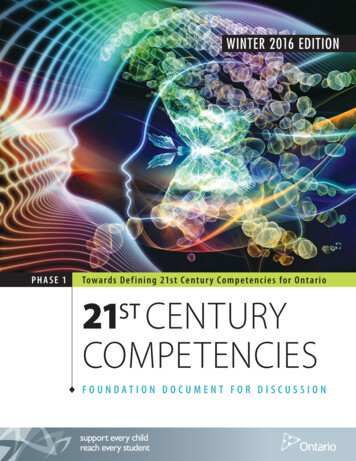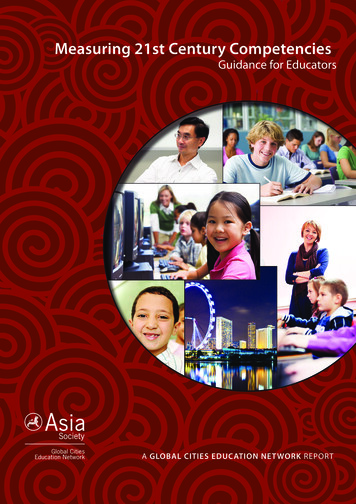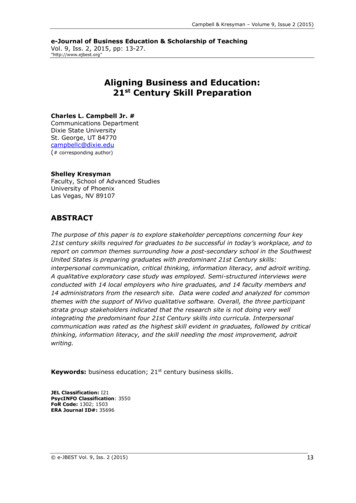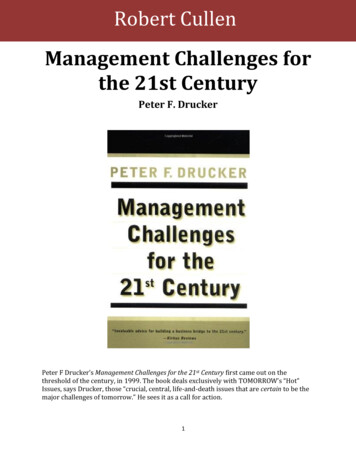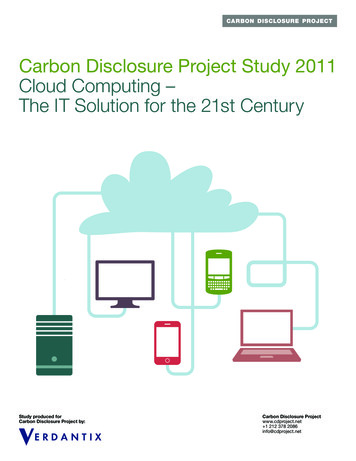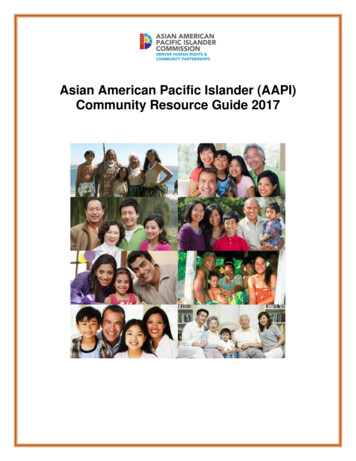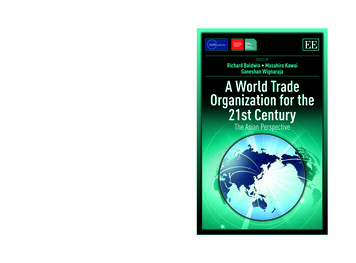
Transcription
The global financial crisis exposed great shortcomings in the global economic architecture,generating extensive international debate about possible remedies for these deficiencies. Postwarglobal architecture was guided by major developed economies, centered around the IMF, the GATT,and the World Bank. Today, the balance of economic power is shifting toward emerging economies.Global governance and economic policy must reflect this shift.The world trading system, led by the World Trade Organization (WTO), is under pressure toevolve and address 21st-century trade issues. Meanwhile, economically salient Asia has builtdeep supply chains over decades, whilst experimenting with mega-regional trade agreementsand economic policies to sustain growth amid a fragile economy. The Asian-led RegionalComprehensive Economic Partnership (RCEP) and the United States-led Trans-Pacific StrategicEconomic Partnership (TPP) are competing to set standards for Asia’s trade and supply chains. Withcontributions from prominent Asian and international trade experts, this book critically examineskey changes occurring in the world trading system and explores policy implications for Asia.Lessons from the Asian experience offer new approaches and economic policies to sustain growth,presenting the WTO as forum for action to improve global and regional trade governance in the21st century.Policy makers will benefit from the expert knowledge and policy lessons presented in this book,and development economists and researchers will profit from its critical examination of the worldtrading system. Undergraduate and postgraduate students interested in development, developmenteconomics, international development, and related fields will find this essential supplementaryreading.Richard Baldwin is Professor of International Economics at the Graduate Institute of Internationaland Development Studies, Geneva, Switzerland, Masahiro Kawai is Project Professor at theGraduate School of Public Policy, University of Tokyo, Japan and Ganeshan Wignaraja is Directorof Research at the Asian Development Bank Institute, Tokyo, Japan.ADBI Series on Asian Economic Integration and CooperationCONTACT Andy DriverJOB NO 1464 DATE SENT 17.09.14 TITLE A World Trade Organization for the 21st Century EDITOR Caroline CornishTEL 07944 643920PRODUCTION CONTROLLER Ilsa Williamson ORDER 52368 SPINE BULK 28mm JACKET SIZE Royal PPC 234mm x 156mm COLOURS CMYKEMAIL andy@ombdesign.co.uk PLEASE NOTE Colours on printed laser proofs may differ slightly to those viewed on PDFs due to the nature of laser printing compared to the colour values seen on screen.A World Trade Organization for the 21st Century‘This unique compilation of essays addresses a core political economy question: howdo market forces and trade regulation interact? Its fresh Asian perspective offers amuch-needed contribution to our understanding of how treaty-based regional andbilateral economic integration is driven by the Factory Asia phenomenon. The authorsalso compellingly show where the World Trade Organization could fit in. An informativeread for scholars and experts alike.’Manfred Elsig, University of Bern, SwitzerlandRichard Baldwin Masahiro Kawai Ganeshan WignarajaA World Trade Organization for the 21st CenturyEDITED BYRichard Baldwin Masahiro KawaiGaneshan WignarajaA World TradeOrganization for the21st CenturyThe Asian Perspective
A World Trade Organization for the 21stCentury
ADBI SERIES ON ASIAN ECONOMIC INTEGRATION ANDCOOPERATIONPrevious titles published in association with ADBI include:Infrastructure and Trade in AsiaEdited by Douglas H. Brooks and Jayant MenonInfrastructure’s Role in Lowering Asia’s Trade CostsBuilding for TradeEdited by Douglas H. Brooks and David HummelsTrade Facilitation and Regional Cooperation in AsiaEdited by Douglas H. Brooks and Susan F. StoneManaging Capital FlowsThe Search for a FrameworkEdited by Masahiro Kawai and Mario B. LamberteThe Asian TsunamiAid and Reconstruction after a DisasterEdited by Sisira Jayasuriya and Peter McCawleyAsia’s Free Trade AgreementsHow is Business Responding?Edited by Masahiro Kawai and Ganeshan WignarajaMonetary and Currency Policy Management in AsiaEdited by Masahiro Kawai, Peter J. Morgan and Shinji TakagiImplications of the Global Financial Crisis for Financial Reform and Regulationin AsiaEdited by Masahiro Kawai, David G. Mayes and Peter J. MorganInfrastructure for Asian ConnectivityEdited by Biswa Nath Bhattacharyay, Masahiro Kawai and Rajat M. NagA World Trade Organization for the 21st CenturyThe Asian PerspectiveEdited by Richard Baldwin, Masahiro Kawai and Ganeshan WignarajaThe Asian Development Bank Institute (ADBI), located in Tokyo, is the thinktank of the Asian Development Bank (ADB). ADBI’s mission is to identify effective development strategies and improve development management in ADB’sdeveloping member countries. ADBI has an extensive network of partners inthe Asia and Pacific region and globally. ADBI’s activities are aligned withADB’s strategic focus, which includes poverty reduction and inclusive economicgrowth, the environment, regional cooperation and integration, infrastructure development, middle-income countries, and private sector development andoperations.
A World TradeOrganization for the21st CenturyThe Asian PerspectiveEdited byRichard BaldwinProfessor of International Economics, Graduate Institute ofInternational and Development Studies, Geneva, SwitzerlandMasahiro KawaiProject Professor, Graduate School of Public Policy, Universityof Tokyo, JapanGaneshan WignarajaDirector of Research, Asian Development Bank Institute,Tokyo, JapanEdward ElgarCheltenham, UK Northampton, MA, USA
Asian Development Bank Institute 2014All rights reserved. No part of this publication may be reproduced, stored in aretrieval system or transmitted in any form or by any means, electronic,mechanical or photocopying, recording, or otherwise without the priorpermission of the publisher.Published byEdward Elgar Publishing LimitedThe Lypiatts15 Lansdown RoadCheltenhamGlos GL50 2JAUKEdward Elgar Publishing, Inc.William Pratt House9 Dewey CourtNorthamptonMassachusetts 01060USAA catalogue record for this bookis available from the British LibraryLibrary of Congress Control Number: 2014941551This book is available electronically in the ElgarOnline.comEconomics Subject Collection, E-ISBN 978 1 78347 928 3ISBN 978 1 78347 927 6Typeset by Servis Filmsetting Ltd, Stockport, CheshirePrinted and bound in Great Britain by T.J. International Ltd, Padstow
ContentsList of contributors viiForeword by Pascal Lamy ixPreface xiiiList of abbreviations xiv1Introduction and overview Richard Baldwin, Masahiro Kawai and Ganeshan Wignaraja2WTO 2.0: governance of global supply- chain trade Richard Baldwin1123 Trade in value added: concept, development, and an EastAsian perspective Satoshi Inomata484Joining the supply chain: a firm- level perspective Ganeshan Wignaraja715Effective industrial policies and global value chains Patrick Low and Julia Tijaja1106 Mapping crisis- era protectionism in the Asia and Pacificregion 130Simon J. Evenett7 Exchange rate policy and regional trade agreements: a case ofconflicted interests? Victor Pontines and Richard Pomfret1578 Policy challenges posed by Asian free trade agreements: areview of the evidence Masahiro Kawai and Ganeshan Wignaraja1829 Constructing and multilateralizing the RegionalComprehensive Economic Partnership: an Asianperspective 239Shujiro Uratav
viA World Trade Organization for the 21st century10 The ASEAN Economic Community: progress, challenges, andprospects 269Siow Yue Chia11The future of the World Trade Organization Biswajit Dhar31612 Plurilateral agreements: a viable alternative to the WorldTrade Organization? Michitaka Nakatomi36113 The role of foreign direct investment flows and a possiblemultilateral agreement Yunling Zhang and Rongyan Wang403Index 421
ContributorsRichard Baldwin is Professor of International Economics at the GraduateInstitute of International and Development Studies, Geneva, Switzerland.Siow Yue Chia is Senior Research Fellow at the Singapore Institute ofInternational Affairs.Biswajit Dhar is Director General of the Research and Information Systemfor Developing Countries and Professor at the Centre for EconomicStudies and Planning, Jawaharlal Nehru University, New Delhi, India.Simon J. Evenett is Professor of International Trade and EconomicDevelopment, University of St Gallen, Switzerland.Satoshi Inomata is Chief Senior Researcher at the Institute of DevelopingEconomies (IDE- JETRO), Chiba, Japan.Masahiro Kawai is Project Professor at the Graduate School of PublicPolicy, University of Tokyo. He was formerly Dean and CEO of the AsianDevelopment Bank Institute, Tokyo, Japan.Patrick Low is Vice President of Research at the Fung Global Institute,Hong Kong, China.Michitaka Nakatomi is Consulting Fellow at the Research Institute ofEconomy, Trade and Industry, Tokyo, Japan.Richard Pomfret is Professor, School of Economics, University ofAdelaide, Australia.Victor Pontines is Research Fellow at the Asian Development BankInstitute, Tokyo, Japan.Julia Tijaja is Assistant Director/Senior Economist at the ASEANIntegration Monitoring Office (AIMO) of the ASEAN Secretariat,Jakarta, Indonesia. She was formerly Research Analyst at the FungGlobal Institute, Hong Kong, China.Shujiro Urata is Professor of Economics at the Graduate School of Asia- Pacific Studies, Waseda University, Tokyo, Japan.vii
viiiA World Trade Organization for the 21st centuryRongyan Wang is Associate Professor, Tianjin University of Finance andEconomics, People’s Republic of China.Ganeshan Wignaraja is Director of Research at the Asian DevelopmentBank Institute, Tokyo, Japan.Yunling Zhang is Professor and Director of International Studies, ChineseAcademy of Social Sciences, Beijing, People’s Republic of China.
ForewordAsia is a vast continent with large heterogeneity – physically, culturally,linguistically, politically, and economically. The region includes someof the world’s most competitive and sophisticated economies, as well aslarge emerging ones which are fast becoming important global players.At the same time, they coexist with numerous smaller, poorer, and morevulnerable economies, including landlocked and island states. Despite itsrapid economic growth, Asia still remains the home to nearly a half ofthe world’s poor. The region is facing numerous challenges, ranging fromrising inequalities and disparities, limited natural resources, and vulnerability to climate change and risk of falling into the ‘middle income trap’,all of which have implications for the rest of the world.The past few decades witnessed the rapid economic take- off of theregion. Asia’s share in world merchandise trade has grown from around13 percent in 1960 to over 32 percent in 2012. Asia is projected to growand account for more than half of global gross domestic product (GDP),trade, and investment, and enjoy widespread affluence by the middle ofthe 21st century.Trade has played a key role in shaping the transformation of Asianeconomies in the recent history. Asia is a living example of how trade cancontribute to economic development. The trade share of GDP in Asia hasgrown from 13 percent in 1960 to 60 percent by 2012. During the sameperiod, hundreds of millions of people have been lifted out of poverty. It ismy belief that trade will continue to play a defining role for Asia’s futureprosperity.Integration – both regional and global – has been central to Asian prosperity. The share of intra- regional trade in Asia’s merchandise trade hasgrown from about 20 percent in 1960 to over 50 percent in 2012. Asia’srapid economic growth owes much to the development of webs of supplychains and production networks, often known as ‘Factory Asia’.Today, nearly 60 percent of the volume of world merchandise trade istrade in components. In Asia, the figure is closer to two- thirds. This owesmuch to services, including transport, communications, and other business services which become key components in the operation of supplychains. The same can be said of relatively low tariffs on industrial productsix
xA World Trade Organization for the 21st centuryand little escalation in the tariff structures. Foreign direct investment(FDI) has also played a big role in the expansion of trade in intermediategoods in Asia.There is a debate on the causality between the growing supply chainsand the number of free trade agreements (FTAs) in Asia. In fact, Asia is arelative latecomer to FTAs, only increasing its involvement over the pastdecade, albeit at a dramatic scale. The number of ratified FTAs grew from36 in 2002 to 113 in the beginning of 2014. The development of supplychains in Asia has been driven by businesses, and it is the FTAs thatare catching up with business reality of more trade and investment. Thekey driver of regional integration through FTAs is to reduce the costs oftrading, through the improvement of quantity and quality of infrastructure, the quality of logistics, the quality of institutions and the competitiveness of the economy. As tariffs are generally not a significant barrieranymore, these agreements have increasingly focused on non- tariff tradefacilitation measures, both at and behind borders.The coexistence between FTAs and the multilateral trading system islikely to continue for the foreseeable future. The key is how best to pursuecoherence between them. In light of the growing supply chains as the basisfor deepening Asia’s regional and global integration, there is a need for apath toward gradual multilateralization: the extension of existing arrangements in a non- discriminatory manner to additional parties. Some recentinitiatives to consolidate intra- regional FTAs into a broader regionalagreement – such as the Regional Comprehensive Economic Partnership(RCEP) by the Association of Southeast Asian Nations (ASEAN) plusAustralia, the People’s Republic of China, India, Japan, the Republicof Korea, and New Zealand (ASEAN16) members or the tripartiteFTA among the People’s Republic of China, Japan, and the Republicof Korea – could be a stepping stone in that direction. It is important,however, that such convergence efforts should not end up in an agreementof the lowest common denominators or a closed agreement.The case for multilateralization is particularly strong in Asia. First,the idea of ‘open regionalism’ originated in the Asia- Pacific EconomicCooperation (APEC) context in 1996, as an option to extend the benefitsof the ASEAN FTA accords to non- members on a most- favored- nation(MFN) basis. While this idea was not formally adopted, APEC economieshave embraced it and practice it on a range of products.Second, Asia is increasingly focusing on inter- regional FTAs, outreaching other continents, whether between economies on both sides of thePacific Ocean or with Europe, in addition to the already existing inter- regional fora such as APEC and the Asia–Europe Meeting (ASEM).Third, recent Asian FTAs focus more on reducing non- tariff measures,
Foreword xiinvolving standards, technical regulations, certification procedures, services regulations, prudential rules, and others. While these measures aremore complicated to negotiate than tariffs, once an agreement is reached,their implementation would not only be easier, but also less costly andmore efficient, if done in a non- discriminatory fashion.Fourth, unilateral trade opening is one form of multilateralization thathas been practiced widely as part of domestic reforms. This is especiallytrue in Asia.Finally, while multilateralization itself does not automatically translateinto multilateral accords, locking in these trade opening efforts in theWorld Trade Organization (WTO) can provide credibility, transparency,and predictability, which are central to a smooth operation of supplychains. Given the huge economic and systemic interests involved in themaintenance of an open, well- functioning trading system, Asia could proactively contribute to strengthening the global trading system by bringingtheir negotiating energies back to the WTO, ensuring greater coherenceand synergies in their trade- opening efforts at the regional and globallevels.While some Asian members might be frustrated at slow progress onthe Doha Development Agenda negotiations, the adoption of the ‘BaliPackage’ at the WTO Ministerial Meeting in December 2013 offers hopefor multilateralism. Indeed, there are areas in which the WTO can complement and facilitate the integration efforts back home. For instance, theconclusion of the Trade Facilitation negotiations helps improve regionalconnectivity by halving logistical and other costs associated with borderand customs procedures. Together with regional institutions, the WTOcan also ensure that Aid for Trade helps build trade capacity in poorerAsian countries, including capacity to implement a WTO trade facilitationdeal. The WTO can also work together with regional institutions to ensureavailability and affordability of trade finance, in particular for small andmedium- sized enterprises (SMEs).Asia has been a successful model of development through trade, whichhas inspired many others around the world. There is no doubt that theregion will continue to inspire the trade community in the decades tocome.With its significant economic and trade weight in the global economy,Asia is expected to shoulder more responsibilities and take the lead in theglobal trading system in the future. Its contribution to formulating a post- Bali agenda will be essential. Asia’s successful experience of facilitatingFactory Asia can also contribute to the challenges of developing betterregulatory convergence in services trade markets, investment rules, andgovernment procurement regimes.
xiiA World Trade Organization for the 21st centuryThis book, edited by Richard Baldwin, Masahiro Kawai, and GaneshanWignaraja, provides a timely analysis of the evolving 21st- century worldtrading system and the role of the WTO. The chapters in the book examinekey changes relating to supply chains and the rules governing trade froman Asian perspective. I believe that they will make a valuable contribution to the debate about how to reform the world trading system and todevelop more coherence between multilateral and regional trade rules.Pascal Lamy
PrefaceThis study was motivated by uncertainty in the governance of the worldtrading system and its economic implications for Asia. The negotiatingfunction of the World Trade Organization appears to be malfunctioningand there is little end in sight for the current Doha Development Roundafter several years of talks. Following the Great Recession, murky non- tariff protectionism remains a risk to trade- led growth. In an uncoordinated manner, a plethora of bilateral free trade agreements are setting newrules for international trade. Large mega- regional arrangements – such asthe Regional Comprehensive Economic Partnership and the Trans- PacificPartnership – are attempting to consolidate and shape such rules into 21st- century trade disciplines. However, the future direction of mega- regionalnegotiations and their relationship with WTO multilateral trade rules areunclear.Against this backdrop, the Asian Development Bank Institute inTokyo and the Centre for Trade and Economic Integration in Genevajointly organized a conference on 11–12 March 2013 on the Future ofthe World Trading System: Asian Perspectives. With its successful modelof outward- oriented development, Asia has increasingly emerged at thecenter of gravity of the world economy. The solutions developed in Asiato the ‘noodle bowl’ problem will be of interest to other regions and likelyinfluence the future course of the world trading system.We gratefully acknowledge valuable comments on the papers providedby session chairs, discussants, and participants at the Geneva conference. Thanks are also due to several individuals who contributed to thepreparation of this study: Victor Pontines, Theresa Carpenter, and MaikaOshikawa organized the Geneva conference. Victor Pontines coordinatedthe preparation of the papers. Robert Davis and Grant Stillman organized publication of the book. Menaka Arudchelvan and Xiaoming Panprovided research assistance.The opinions expressed in this book are those of the authors and do notrepresent the views of the Asian Development Bank Institute or the Centrefor Trade and Economic Integration.Richard Baldwin, Masahiro Kawai, and Ganeshan Wignarajaxiii
AbbreviationsAANZFTA ASEAN–Australia/New Zealand Free Trade AgreementABMIAsian Bond Markets InitiativeACCSQ ASEAN Consultative Committee on Standards andQualityACIAASEAN Comprehensive Investment AgreementACFTAASEAN–PRC Free Trade AgreementACTAAnti- Counterfeiting Trade AgreementADBAsian Development BankAECASEAN Economic CommunityAFASASEAN Framework Agreement on ServicesAFTAASEAN Free Trade AreaAHTNASEAN Harmonized Tariff NomenclatureAIAASEAN Investment AreaAICOASEAN Industrial CooperationAIFASEAN Infrastructure FundAIFTAASEAN–India Free Trade AgreementAIOTAsian International Input–Output TableAJCEPASEAN–Japan Comprehensive Economic PartnershipAKFTAASEAN–Republic of Korea Free Trade AgreementAMROASEAN13 Macroeconomic Research OfficeAMSAggregate Measurement of SupportAoAAgreement on AgricultureAPAECASEAN Plan of Action for Energy CooperationAPECAsia- Pacific Economic CooperationAPLaverage propagation lengthAPTAAsia- Pacific Trade AgreementARICAsia Regional Integration CenterASEANAssociation of Southeast Asian NationsASEAN6 Indonesia, Malaysia, Philippines, Singapore, Thailand,and Viet NamASEAN13ASEAN plus the PRC, Japan, and the Republic of KoreaASEAN16 ASEAN plus Australia, the PRC, India, Japan, theRepublic of Korea, and New ZealandASEMAsia–Europe Meetingxiv
Abbreviations xvASWASEAN single windowATIGAASEAN Trade in Goods AgreementBIMSTEC Bay of Bengal Initiative for Multi- Sectoral Technical andEconomic CooperationBIPAbilateral investment protection agreementBITbilateral investment treatyBRICS Brazil, Russian Federation, India, PRC, and SouthAfricaCECAcomprehensive economic cooperation agreementCEOchief executive officerCEPcomprehensive economic partnershipCEPAcomprehensive economic partnership agreementCEPEAComprehensive Economic Partnership in East AsiaCEPTCommon Effective Preferential TariffCERCloser Economic RelationsCETcommon external tariffCGEcomputable general equilibriumCGIFCredit Guarantee and Investment FacilityCIFcost, insurance, and freightCISCommonwealth of Independent StatesCJKPRC, Japan, Republic of KoreaCJKFTAPRC–Japan–Republic of Korea Free Trade AgreementCLMV Cambodia, Lao People’s Democratic Republic,Myanmar, and Viet NamCMIChiang Mai InitiativeCMIMChiang Mai Initiative MultilateralizationCOCertificate of OriginCSRcorporate social responsibilityCTCchange in tariff classificationCTHchange in tariff headingCUcustoms unionDSBDispute Settlement BodyDSUDispute Settlement UnderstandingEAFTAEast Asia Free Trade AreaECOTECHeconomic and technical cooperationEECEuropean Economic CommunityEEDEquitable Economic DevelopmentEFTAEuropean Free Trade AreaEIAEconomic Integration AgreementEOIexport- oriented industrializationEPAeconomic partnership agreementEPZexport processing zone
xviA World Trade Organization for the 21st centuryEUEuropean UnionFDIforeign direct investmentFOBfree on boardFTAfree trade agreementFTAAFree Trade Area of the AmericasFTAAEFree Trade Area of Asia and EuropeFTAAPFree Trade Area of the Asia- PacificG20Group of TwentyG33Group of Thirty- ThreeGATSGeneral Agreement on Trade in ServicesGATTGeneral Agreement on Tariffs and TradeGCCGulf Cooperation CouncilGDPgross domestic productGELGeneral Exclusion ListGFCglobal financial crisisGMGeneral MotorsGMSGreater Mekong SubregionGPAGovernment Procurement AgreementGPNglobal production networkGTAGlobal Trade AlertGTAPGlobal Trade Analysis ProjectGVCglobal value chainHSharmonized systemIADBInter- American Development BankIAIInitiative for ASEAN IntegrationICSID International Centre for Settlement of InvestmentDisputesICTSD International Centre for Trade and SustainableDevelopmentIDEInstitute of Developing EconomiesIDEAInternational Digital Economy AgreementIIOTinternational input–output tableILInclusion ListIMFInternational Monetary FundIPintellectual propertyIPFSD Investment Policy Framework for SustainableDevelopmentIPRintellectual property rightsISAinternational services agreementISCAinternational supply chain agreementISDSinvestor–state dispute settlementISIimport- substituting industrialization
Abbreviations xviiISOInternational Organization for StandardizationITinformation technologyITAInformation Technology AgreementItIindustrialization through innovationJETROJapan External Trade OrganizationKORUSRepublic of Korea–US Free Trade AgreementLao PDRLao People’s Democratic RepublicLDCleast developed countryLRPlicensing requirements and proceduresMAmarket accessMAImultilateral agreement on investmentMEAmultilateral environmental agreementsMercosurSouthern (American) Common MarketMFNmost favored nationMNCmultinational corporationMOPmargin of preferenceMRAmutual recognition arrangementNAFTANorth American Free Trade AgreementNAMAnon- agricultural market accessNFTCNational Foreign Trade CouncilNGMANegotiating Group on Market AccessNIEnewly industrialized economyNSWnational single windowNTnational treatmentNTBnon- tariff barrierNTMnon- tariff measuresOAoffice automationOECD Organisation for Economic Co- operation andDevelopmentOTDSoverall trade distorting domestic supportP3- CEPPacific Three Closer Economic PartnershipP4Pacific 4PECCPacific Economic Cooperation CouncilPFIPolicy Framework for InvestmentPNproduction networkPPPpurchasing power parityPRCPeople’s Republic of ChinaPSRproduct specific rulePTApreferential trade agreementQRPqualification requirements and proceduresR&Dresearch and developmentRBIresource- based industrialization
xviiiA World Trade Organization for the 21st centuryRCEPRegional Comprehensive Economic PartnershipROOrule of originROWrest of the worldRPTreasonable period of timeRTAregional trade agreementRVCregional value contentS&DTspecial and differential treatmentSAFTASouth Asian Free Trade AgreementSCMAgreement on Subsidies and Countervailing MeasuresSDTspecial and differential treatmentSLSensitive ListSMEssmall and medium- sized enterprisesSOEstate- owned enterpriseSPRspecific process ruleSPSsanitary and phytosanitary standardsSSMspecial safeguard mechanismTAPTrans- Atlantic PartnershipTBTtechnical barriers to tradeTELTemporary Exclusion ListTPPTrans- Pacific Strategic Economic PartnershipTPPATrans- Pacific Partnership AgreementTRIMstrade- related investment measuresTRIPstrade- related intellectual property rightsTStechnical standardsTTIPTransatlantic Trade and Investment PartnershipUNUnited NationsUNCITRAL United Nations Commission on International Trade LawUNCTADUnited Nations Conference on Trade and DevelopmentUNESCAP United Nations Economic and Social Commission forAsia and the PacificUSUnited StatesVAXvalue- added exportVSvertical specializationWGTI Working Group on the Relationship between Trade andInvestmentWIODWorld Input–Output DatabaseWOwholly obtained or producedWTOWorld Trade Organization
1.Introduction and overviewRichard Baldwin, Masahiro Kawai andGaneshan Wignaraja1.1AIM OF THE BOOKThe 1995 creation of the World Trade Organization – as an institutionalextension of the General Agreement on Tariffs and Trade (GATT) – heldout the promise of an effective, rules- based world trading system where allcountries were treated alike. In addition to establishing a global judiciaryfor trade disputes, the WTO was expected to provide a forum for tradenegotiations and undertake other related functions. Progress on the judiciary side has been brilliant, but the negotiation promise is largely unfulfilled (Hoekman and Kostewei 2010).The world trading system is in a state of flux characterized by newdevelopments and uncertainties about global trade governance under theWTO. Fundamental changes are occurring because of the rise of emergingeconomies (such as Brazil, Russian Federation, India, People’s Republicof China, and South Africa – the BRICS), the expansion of internationalproduction networks and supply chains, signs of new commercial andindustrial policies, and the proliferation of free trade agreements globally.These developments are all here to stay but the WTO has not kept up withthem. Furthermore, the WTO Doha Round has been going on for morethan a decade. Despite being the longest multilateral trade talks in history,it shows little sign of concluding comprehensively anytime soon. TheWTO’s centricity in global trade governance is eroding and risks continuing to erode.The profound nature of these developments has prompted a debate onthe future shape of the world trading system and the rules governing trade(Hufbauer and Cimino 2013; Trebilcock 2014; WTO 2013). The chaptersin this book, written by leading Asian and international trade experts,conduct a broad and comprehensive examination of key changes takingplace in the world trading system and traces policy implications for Asia.The links among global production networks and supply chains, nationalcommercial and industrial policies, and the governance of global and1
2A World Trade Organization for the 21st centuryregional trade are also explored in the book. Also, the book offers lessonsfor other regions.The chapters cover several specific issues: stylized patterns, measurement, and participants of global production networks and supply chains;the economic effects of commercial and industrial policies pursuedby countries;the evolving architecture of regional trade governance characterized by the spread of FTAs and attempts at consolidation into largeregion- wide agreements; andthe state of global trade governance centered on the WTO and pr
evolve and address 21st-century trade issues. Meanwhile, economically salient Asia has built deep supply chains over decades, whilst experimenting with mega-regional trade agreements and economic policies to sustain growth amid a fragile economy. The Asian-led Regional



